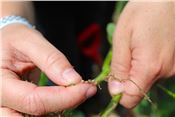Test Fields For SCN And Test Your SCN IQ

Test for soybean cyst nematode before planting, says MU Extension agronomist Pat Miller. SCN is the No. 1 soybean disease in the U.S. and Canada.
Photo by Linda Geist.
NEVADA, MO.
Now is the perfect time to test for the No. 1 soybean disease in the U.S. and Canada - soybean cyst nematode (SCN), says University of Missouri Extension field agronomist Pat Miller. It is also a good time to test your IQ on this yield-reducing disease.
Soybean cyst nematodes attack soybean roots.SCN began spreading in Missouri in the 1970s and gained a strong foothold in most of the state’s soybean-growing counties by the 1990s.
Yields drop by as much as 14 bushels per acre in infected fields when SCN reproduction is high, according to the SCN Coalition, a public-private partnership of researchers, extension specialists and industry representatives.
Populations can increase exponentially. Easily transported by nature, cysts and eggs spread within a field or to new fields by soil, equipment, water or wind.
Miller offers this quick true-false quiz for producers. Answers follow.
1. Soybean cyst nematode is a microscopic roundworm that attacks soybean roots. True / False
2. If you have soybean cyst nematodes, you will always see visual damage to the soybeans. True / False
3. The visible cysts are females that lose their ability to move through the soil. True / False
4. Soybean cyst nematodes cause excessive root growth. True / False
5. Soybean cyst nematodes can be spread by animals. True / False
Answers:
1. True. They are a plant-parasitic microscopic roundworm.
2. False. They can cause 15-30 percent yield reduction without visible symptoms.
3. True. The cysts are females that lose their ability to move and become lemon-shaped objects as they swell. Each cyst can contain up to 500 eggs. The cyst can help them persist for years in a dormant state.
4. False. As they feed on the roots, they remove nutrients, disrupt water uptake and slow root growth.
5. True. Anything that moves soil can spread the nematodes. This includes equipment, wind, water and animals. MU research has shown that waterfowl can ingest soil in one field and deposit cysts in their droppings in another.
For more information, the MU Extension publication “Soybean Cyst Nematode: Diagnosis and Management” (G4450) is available at extension2.missouri.edu/g4450. You can also contact your regional MU Extension agronomist. ∆